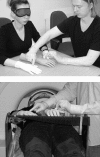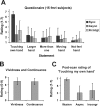Touching a rubber hand: feeling of body ownership is associated with activity in multisensory brain areas
- PMID: 16280594
- PMCID: PMC1395356
- DOI: 10.1523/JNEUROSCI.0800-05.2005
Touching a rubber hand: feeling of body ownership is associated with activity in multisensory brain areas
Abstract
In the "rubber-hand illusion," the sight of brushing of a rubber hand at the same time as brushing of the person's own hidden hand is sufficient to produce a feeling of ownership of the fake hand. We shown previously that this illusion is associated with activity in the multisensory areas, most notably the ventral premotor cortex (Ehrsson et al., 2004). However, it remains to be demonstrated that this illusion does not simply reflect the dominant role of vision and that the premotor activity does not reflect a visual representation of an object near the hand. To address these issues, we introduce a somatic rubber-hand illusion. The experimenter moved the blindfolded participant's left index finger so that it touched the fake hand, and simultaneously, he touched the participant's real right hand, synchronizing the touches as perfectly as possible. After approximately 9.7 s, this stimulation elicited an illusion that one was touching one's own hand. We scanned brain activity during this illusion and two control conditions, using functional magnetic resonance imaging. Activity in the ventral premotor cortices, intraparietal cortices, and the cerebellum was associated with the illusion of touching one's own hand. Furthermore, the rated strength of the illusion correlated with the degree of premotor and cerebellar activity. This finding suggests that the activity in these areas reflects the detection of congruent multisensory signals from one's own body, rather than of visual representations. We propose that this could be the mechanism for the feeling of body ownership.
Figures






References
-
- Bahrick LE, Watson JS (1985) Detection of intermodal proprioceptivevisual contingency as a potential basis of self-perception in infancy. Dev Psychol 21: 963-973.
-
- Blakemore SJ, Wolpert DM, Frith CD (1998) Central cancellation of self-produced tickle sensation. Nat Neurosci 1: 635-640. - PubMed
-
- Blakemore SJ, Frith CD, Wolpert DM (2001) The cerebellum is involved in predicting the sensory consequences of action. NeuroReport 12: 1879-1884. - PubMed
-
- Botvinick M (2004) Neuroscience. Probing the neural basis of body ownership. Science 305: 782-783. - PubMed
Publication types
MeSH terms
Substances
Grants and funding
LinkOut - more resources
Full Text Sources
Other Literature Sources
